Our Highlander Priest deck list guide goes through the ins-and-outs of this Control Priest archetype that has become the go-to Priest deck in Scholomance Academy! This guide will teach you how to mulligan, pilot, and substitute cards for this archetype!
Introduction to Highlander Priest
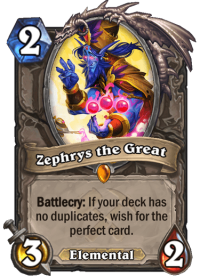
As long as Zephrys the Great and Dragonqueen Alexstrasza remain in the Standard format – until April 2021 – the option to build any deck as a Highlander variant is something you have to consider. Highlander decks typically increase in power as the card pool grows because then you will have more options for doing things and if you have two competing alternatives, a Highlander deck will simply run both as single copies, accept that one is slightly inferior, and more than make up the difference with the power of Zephrys the Great and Dragonqueen Alexstrasza.
Scholomance Academy gave Priest a plethora of powerful new cards and propelled Highlander Priest to become a true alternative to decks that run duplicates. Scholomance Academy Highlander Priest remains a Galakrond Control Priest at heart, focusing on the power of removal and thievery and finally the Hero Power of Galakrond, the Unspeakable to generate infinite threats that put the value that any other control deck can generate to shame.
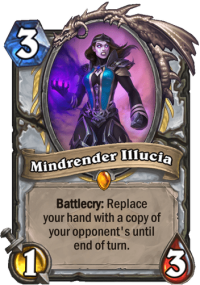
With the addition of Mindrender Illucia, Priest also has the most powerful anti-combo tool in the game, turning previously unwinnable matchups into a race of whether the combo deck can kill Priest before Priest draws Illucia and destroys the combo pieces.
All of this makes Priest an extremely powerful class: it is nigh undefeatable in the late game and any board you can build against them can be destroyed or stolen at any time. Priest’s main weakness is the lack of card draw, and it is possible to defeat Priest through tempo by overwhelming them before they find enough defensive tools. Decks that keep presenting new threats at a fast pace are poison to Priest as even though Priest has all the removal they ever need in the deck, they can run out of removal in hand unless they get a spectacular draw. As a Priest player, you need to evaluate which tools to use and when so that you avoid running out of slowly replenished answers.
Highlander Priest Deck List
Highlander decks have a lot of variation between them because they consist of singleton cards. This sample list has had success on the ladder, but it is by no means the only way to build the deck.
- 0Forbidden Words1

- 0Highlander Priest Deck List & Guide – Scholomance Academy – September 20201
- 0Highlander Priest Deck List & Guide – Scholomance Academy – September 20201
- 0Highlander Priest Deck List & Guide – Scholomance Academy – September 20201
- 0Highlander Priest Deck List & Guide – Scholomance Academy – September 20201
- 0Highlander Priest Deck List & Guide – Scholomance Academy – September 20201
- 0Highlander Priest Deck List & Guide – Scholomance Academy – September 20201
- 0Highlander Priest Deck List & Guide – Scholomance Academy – September 20201
- 0Highlander Priest Deck List & Guide – Scholomance Academy – September 20201
- 0Highlander Priest Deck List & Guide – Scholomance Academy – September 20201
- 1Renew1

- 2Penance1

- 2Sethekk Veilweaver1

- 2Thoughtsteal1

- 3Apotheosis1

- 3Breath of the Infinite1

- 3Mindflayer Kaahrj1

- 3Mindrender Illucia1

- 3Shadow Madness1

- 4Cabal Acolyte1

- 7Galakrond, the Unspeakable1

- 7Soul Mirror1

- 9Plague of Death1

Check out alternative versions of this deck on our Highlander Priest archetype page!
Highlander Priest Mulligan Strategy & Guide
VS Fast Decks
Higher Priority (Keep every time)
- Zephrys the Great – A flexible answer to any situation.
- Disciple of Galakrond – An unconditional one-drop to start the game with.
- Imprisoned Vilefiend – Great early-game board control minion.
- Penance – Early removal spell.
Lower Priority (Keep only if certain conditions are met)
- Raise Dead – Keep with Zephrys to be able to play it twice.
- Apotheosis – Keep with Imprisoned Vilefiend for an early healing package.
VS Slow Decks
Higher Priority (Keep every time)
- Zephrys the Great – A flexible answer to any situation.
- Disciple of Galakrond – An unconditional one-drop to start the game with.
Lower Priority (Keep only if certain conditions are met)
- Raise Dead – Keep with Zephrys to be able to play it twice.
- Mindrender Illucia – Keep if you know you’re playing against a combo deck.
Highlander Priest Play Strategy
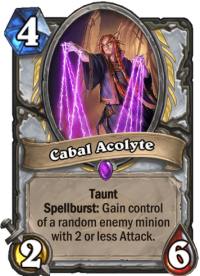
Highlander Priest is a control deck. Your primary goal is to survive and outvalue the opponent. Thanks to the Hero Power of Galakrond, the Unspeakable that generates random Priest minions for you, you have more value than any other deck in the game.
This does not mean that you always have to passively sit and wait forever, although there is not exactly a whole lot you can do in the first turns of a game. In fact, there are several ways for you to swing the game in your favor and become aggressive, depending on the exact list that you play with:
- Cabal Acolyte and Cabal Shadow Priest can steal individual minions, including powerful ones when used in combination with Wave of Apathy or Lazul's Scheme. Shadow Madness can do the same, but only temporarily: it is best used to steal Deathrattle effects by running the stolen minion to its death.
- Headmaster Kel'Thuzad can summon a destroyed minion on your side (without buffs). It is powerful with Shadow Word: Death, Time Rip, or Shadow Word: Ruin.
- Mindflayer Kaahrj can summon a copy of an opponent’s minion as its Deathrattle. Strong as an on-curve tempo play or in combination with a removal piece to destroy the original.
- Murozond the Infinite plays all the cards your opponent played on the previous turn. Note that any Battlecry effects do not trigger, you only get the minions/spells/Hero. Great to play after a Wondrous Wand, less so after the opponent’s Murozond the Infinite.
- Soul Mirror can give you a board of damage minions if the opponent has minions with more health than attack. Combine with Breath of the Infinite while holding a Dragon to get rid of the originals afterward.
As you can see, just about all of your power plays depend on your opponent doing something first, which then allows you to copy or steal minions while destroying the originals. It is difficult to pressure a passive opponent as Highlander Priest, but you can turn the tables on an active opponent and get aggressive after taking care of their board.
If you are able to build a board, you can get some surprising burst turns with Kronx Dragonhoof buffing all your minions by +2/+2 (only when you are in Galakrond form) or with Zephrys the Great providing Bloodlust or Savage Roar.
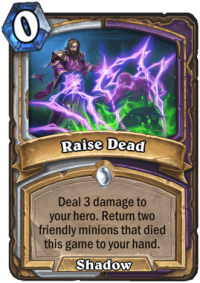
Raise Dead is an interesting value card for Highlander Priest because if you have it in your hand early in the game, you are able to set up guaranteed generated minions: for example, with Raise Dead in hand, you can play an early Zephrys the Great because you are guaranteed to get a new copy if you play Raise Dead after Zephrys and only one other minion have died on your side of the board.
Apotheosis has many uses in the deck, depending on what minions you have chosen to include. It works well with Rush minions such as Imprisoned Vilefiend and Ruststeed Raider, as well as with minions that deal area-of-effect damage and thereby heal you for all of that damage, such as Wild Pyromancer and Wretched Tutor.
Sethekk Veilweaver can be a major value engine when used with cheap targetable spells. Try to combine it with cards such as Penance and Shadow Word: Death, and potentially also with Renew to get a discovered spell and a random spell if you cast Renew on a minion.
Mindrender Illucia is a challenging new card to use. Her main use is to obliterate combo decks by playing her in the late game to spend some of the combo pieces and thereby deny the combo deck’s win condition. However, there is a lot more to her than that. Remember that you also give your hand to your opponent for a turn, so avoid giving away a hand that will lose the game, such as a hand with your Galakrond in it. Conversely, you will almost certainly win a mirror match if you can Illucia your opponent’s Galakrond and leave them without a more powerful Hero. Against aggressive decks, playing Illucia on turn two can help you scout what they have – and waste their Coin if it is still left – while lending the opponent a hand that most likely includes no playable cards because you do not have many inexpensive cards in the deck.
VS Aggro Decks
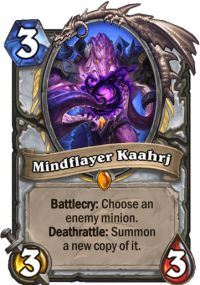
Against aggro decks, your only goal is survival. If you survive long enough, you win. Do not attempt to maximize the value of all of your plays but instead prevent the opponent from gaining too much tempo. Some examples:
- Mindflayer Kaahrj on just about any small minion is fine. It is still a 3/3 with a Deathrattle to summon another minion and it can help you fight for the board. You do not need an 8/8 out of it, even a 2/2 can be enough.
- Mindrender Illucia on turn two is fine. Delay the opponent. Waste their Coin if you can. They are unlikely to get any playable cards from your hand anyway.
- Penance an early threat even if you are not yet damaged. It’s fine, you don’t have to make use of the Lifesteal part if that prevents the opponent from snowballing their board out of control. You can save it if the minion on the board is not scary.
- Zephrys the Great is a little trickier and depends on what you expect the opponent to be able to do, but sometimes you just play it for a Backstab and a 3/2 body on the board.
The key thing you need to learn from experience is how greedy you can be. Sometimes you want the opponent to play more into your removal, but much of the time you need to clear minions before things get too scary.
VS Control Decks
Against control decks, you need to know how your answers line up against the opponent’s threats. You have some great stealing and copying cards, and finding the right targets for each gives you a bigger and bigger advantage until your opponent cannot keep up anymore.
You can win slow games in three different ways:
- You fatigue your opponent as you draw hardly any cards and are thus in a good position at the end after all resources have been depleted.
- You generate infinite minions from Galakrond, and grind out the opponent through value.
- You achieve major tempo swings from counter-punching after your opponent’s big plays with steals and copies, such as Cabal Acolyte and Soul Mirror.
Keep an eye on any of these opportunities and try to direct the game to one of these outcomes.
Highlander Priest Card Substitutions
Highlander decks are notoriously expensive and Highlander Priest is no exception. While some of the cards can be replaced, you will need many expensive cards to play a deck like this. Zephrys the Great and Dragonqueen Alexstrasza are the reasons to play a Highlander deck in the first place. Without them, you are better off with a deck that runs duplicates.
Here is a list of some cheaper cards that sometimes make the cut and sometimes are left out. They can be used to fill in for some of the more expensive cards.
- Wretched Tutor: Area-of-effect damage can be useful in a variety of matchups.
- Ruststeed Raider: Useful Rush minion, for example to replace Siamat.
- Shield of Galakrond: Taunt minion with an Invoke effect for your Galakrond.
- Mass Dispel: Potentially useful tech card against buffs.
- Draconic Studies: Cheap spell to activate Spellburst, can help to gain tempo with Dragons.
- Silence: Potentially useful tech card against buffs, works well with Sethekk Veilweaver.
- Acidic Swamp Ooze: Potential tech card against weapons.
- Wandmaker: Spell generation.
- Cobalt Spellkin: Spell generation.
- Wild Pyromancer: Area-of-effect damage.
Leave a Reply
You must be logged in to post a comment.








Gracias, me ha servido bastante y es mi clase favorita. Excelente post